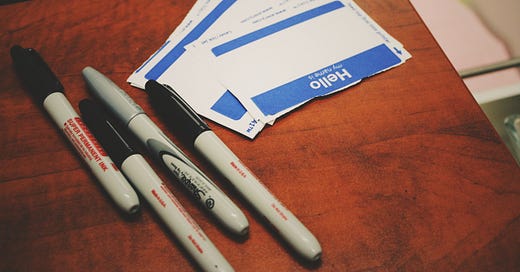Photo by Jon Tyson on Unsplash
As my students launch their NaNoWriMo novel next month, they wanted to spend some time considering their character’s names. Students will spend every day with these characters in November, so choosing names deliberately will aid in understanding the character. For my current novel, I have changed the protagonist’s name from Stacy to Sherilyn to Raylene to Rae each time getting closer to the character as I see her.
Whether you’re writing about a fallen aristocrat, an anxious spaceship captain, or an inept serial killer, the name will become crucial to the reader’s relationship with that character. It's one of the first connections the reader has with your story. Spend any time reading Crime and Punishment and you will be dying for a Tim or Tom, but the length of the name isn’t as important as if the name fits the character’s personality. A Lilibet Diana Mountbatten Windsor by any other name would be a royal.
In many ways, great characters become their names. Consider Nurse Ratched, Darth Vader, Ebenezer Scrooge, Forrest Gump, or Holly Golightly. These character names supersede the author and the literature that gave them voice in the first place.
As you begin naming your characters, consider the following questions:
What genre are you writing?
Historical romance set in the United States West in the 1890s might need a Willie, Charles, or John romancing a Hazel, Grace, or Ida for authenticity. If your sci-fi novel is set in GN-z11, a galaxy 32 billion light-years away, you can be free to get a little creative with the names. A character’s name often reflects the genre or the theme. Read this fantastic analysis of the names in Suzanna Collins’ Hunger Games by Slate’s Miriam Krule as she shows how the names create thematic path through the dystopian novel.
When was your character born?
Is your novel set in the 1890s? 1900s? The 50s or the 70s? To find popular male and female names of a particular era, reference the website Popular Baby Names by Decade which has tracked baby names in the United States since the 1880s. Select two or three names from this list and create mash-ups (see below) that capture the flavor of the age, but are original to your novel. Check out the Wikipedia page for the first name of your character (here’s Elizabeth as an example) which will provide you with a list of other fictional characters as well as occurrences in the Bible, mythology, saints, and historical personages bearing that name.
Where was your character born?
Depending on your character’s location, their name can reflect their geography. How can you lean into the setting through your character’s name? My name, Elizabeth, for example, has a different flavor depending on the geographical form. Elisabet is the original Greek spelling, but Elspeth is the Scottish form, Else and Elisabeth are the French forms; Lusa, the Finnish form; Erzsebet, the Hungarian, and Lise the German form. Consider also the nicknames Lizzie, Lizzy, Lib, Libby, Libbie, Liz, Lisa, Tetsy, Tetty, Tibbie, Beth, Bethia, Betsy, Betsey, Bettie, Bettina, Betty, Bet, Bess, Bessie, and Betsy. All of these carry a different personality and character flavor that can reflect culture and geography.
What is your character’s personality like?
Names often give a reader insight or revelation about the character’s personality, obsessions, or emotional state. Before settling on a name, consider researching its meaning on a website like Behind the Name or Nameberry. Of course, you don’t have to be as on-the-nose as Nathaniel Hawthorne’s allegorical Faith in “Young Goodman Brown” or the symbolic Roger Chillingworth in The Scarlet Letter, but understanding any hidden meaning in the name makes a rich layer for the character and a delightful discovery for the reader.
What are other characters named?
For some reason, student writers often want to name all their characters with the same beginning letter, like Lisa, Laura, Lorrie, or names that sound alike, such as Timmy, Kimmy, and Jimmy. This is tiresome and unrealistic. Think of your friend group and the variety of names represented. (Consider the rich cross-section of my student’s names: Jamia, Reyna, Sawyer, Adyson, Kailie, Eliza, and Maddy) Unless you’re George RR Martin, who has hundreds of characters, give your characters distinctive names. (Here’s a short vid on his process of naming characters and another dive for coming up with names for his A Song of Ice and Fire series.)
Happy Naming
If all else fails, you can spend some time fooling around with an online character name generator, but I’ve never had much luck with these. Behind the Name hosts a name generator feature which allows you to choose cultural, mythological, and historical elements for your character. Reedsy hosts a Character Name Generator that has 1,000,000+ names in its database, including fantasy names, medieval gods and goddesses, and archetypal names.
Here’s a fun Name Mash-Up Recipe I use with my students that I’ve adapted from Self-Publishing School’s Bella Rose Pope.
Write down six real-life names.
(Example: Elizabeth, Bailey, Torrance, Pearl, Colette, Victoria)
Take the first half of the first name and match it, in various places, with the last half of the second name.
Example: Elizaley, Elizley, Eliziley, Elizabeley
Take the last half of the first name and match it, in various places, with the first half of the second name.
Example: Bethbail, Abethba, Zabeba, Ethbai
Repeat the first half/last half matching with names three and four, and names five and six. Play around with the point of attachment to get variety.
Say the names out loud to make sure they aren’t torture for the reader. For example, I would never saddle a character with a name like "Elizabeley” just because it’s so hard to say, but I love “Abethba” and “Zabeba” which roll off the tongue and have an original vibe.




